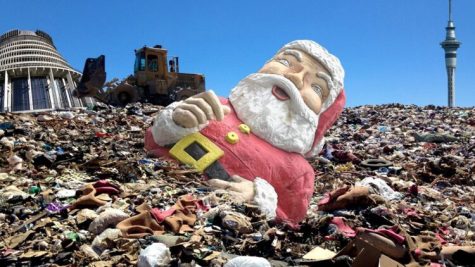
Makenzie Drunasky | Writer
December 10, 2024
The Christmas season, known for its festive spirit, family gatherings, and joyous celebrations, also comes with an environmental cost. From excess packaging to wasteful decorations, the holiday season can take a toll on our planet. But as awareness of climate change grows, many are turning to more sustainable ways to celebrate. By rethinking our holiday traditions and opting for eco-friendly alternatives, we can reduce our environmental footprint while still enjoying all the magic Christmas has to offer.
One of the main contributors to Christmas waste is the massive amount of disposable wrapping paper. According to a 2020 report by National Geographic, Americans alone throw away about 4 million tons of wrapping paper and shopping bags each holiday season. Much of this paper ends up in landfills, where it can take years to decompose, especially since many gift wraps are coated in plastic or glitter. In addition, the production of wrapping paper itself contributes to deforestation and resource depletion.
“Wrapping paper is something we don’t think about, but it’s such a waste,” says Emily Saw, a sophomore at SCHS. “I started using reusable cloth bags or old newspapers to wrap gifts, and it feels a lot better to know I’m not just contributing to landfill waste.”
Another significant environmental impact comes from Christmas trees. While natural trees are biodegradable and can be recycled, many artificial trees are made from PVC, a non-biodegradable plastic, and can take centuries to decompose. Furthermore, the production of artificial trees involves considerable energy and emissions. However, there are ways to enjoy a Christmas tree sustainably. Opting for a locally grown real tree, ensuring it is recycled after use, or choosing a potted tree that can be replanted after the season are all eco-friendly alternatives.
“The Christmas tree is such an iconic part of the holiday, but I never realized how much it contributes to waste,” says sophomore Ryan Cuenca. “This year, I’m getting a potted tree that I can plant in my yard, which feels like a win for both the holiday and the environment.”

Christmas decorations also add to the environmental burden. Many of the common decor items–plastic ornaments, tinsel, and string lights–are often made from non-recyclable materials, contributing to waste. Instead, people can explore sustainable decoration options such as using natural materials like pinecones, cinnamon sticks, and dried fruit for ornaments. These can be composted after the season, reducing their environmental impact.
For those who love lights, energy-efficient LED lights are a great alternative. They use less electricity and last much longer than traditional incandescent bulbs, cutting both energy consumption and waste. “I swapped out my old string lights for LED ones last year, and it’s a small change that’s definitely better for the planet,” adds Emily.
Additionally, the overconsumption of single-use items during the holiday season–plastic cups, plates, and cutlery–adds to the environmental burden. Opting for reusable items or compostable plates and utensils is a simple way to make a difference. Even small choices, like sending e-cards instead of paper ones, can significantly reduce the amount of paper waste generated during the holidays.
As we approach this festive season, it’s important to remember that sustainability doesn’t mean sacrificing the joy of Christmas. Simple changes–whether it’s swapping out plastic decorations for natural ones, choosing eco-friendly wrapping options, or investing in energy-efficient lights–can go a long way in making the holiday season greener.
Christmas is about giving, and this year, let’s give the planet a gift of sustainability. The environment will thank us, and future generations will have a beautiful world to celebrate in.

Leave a Reply